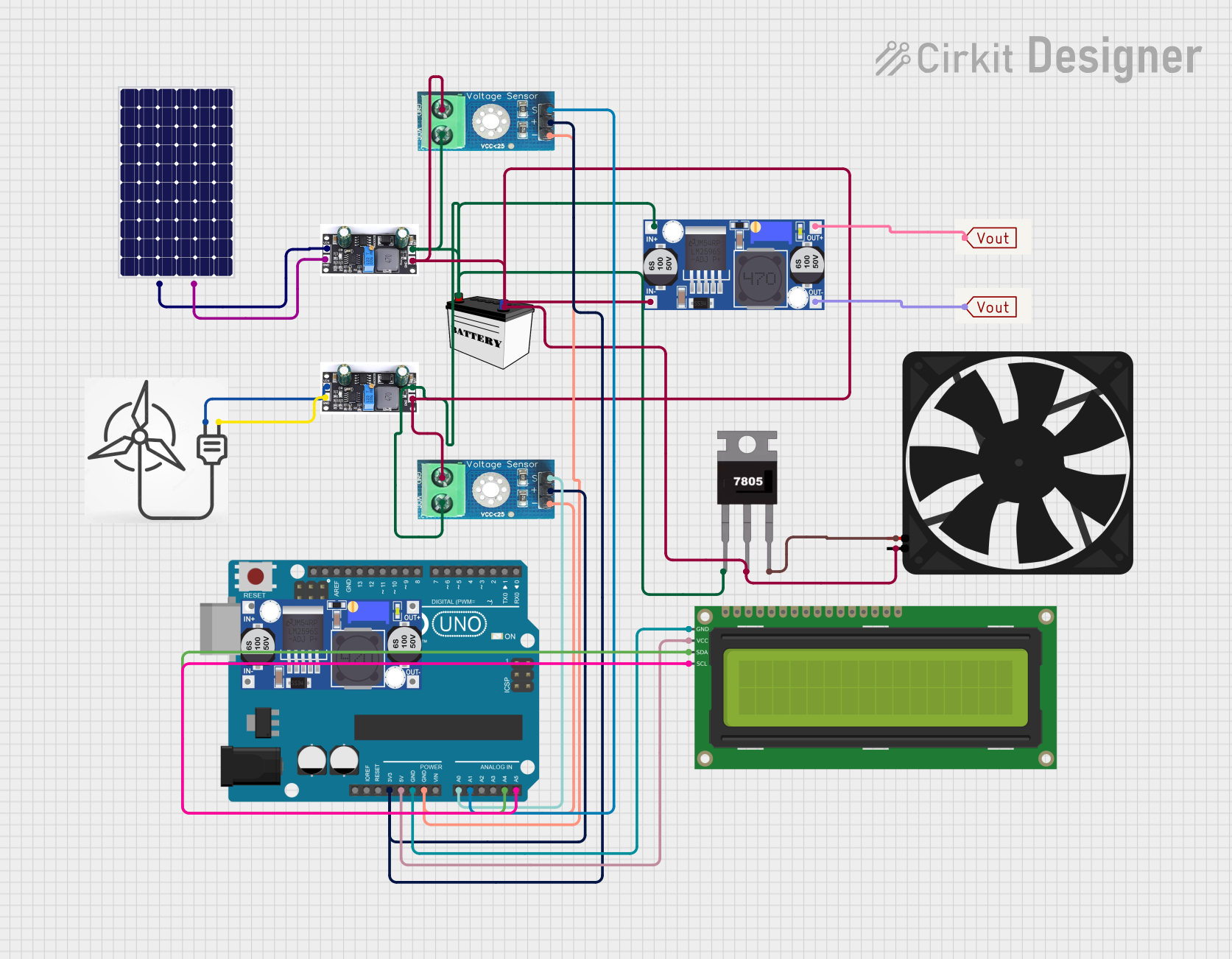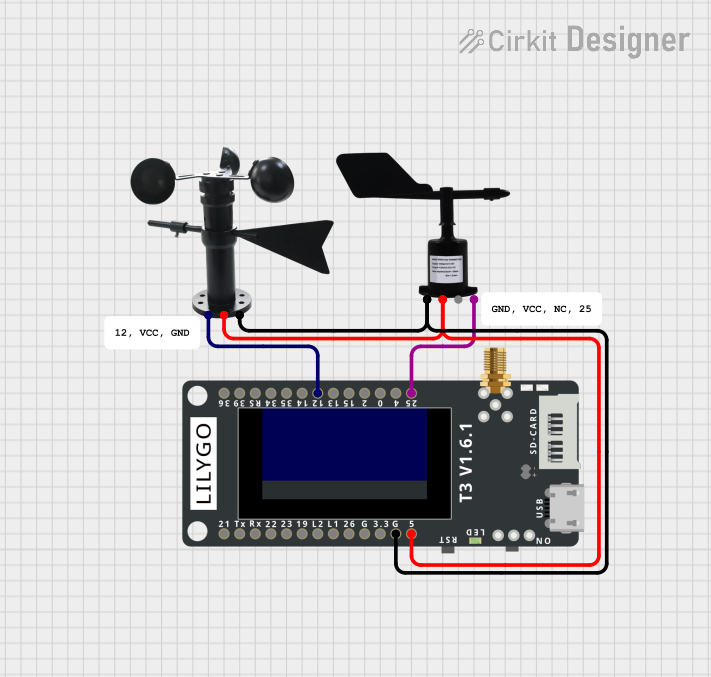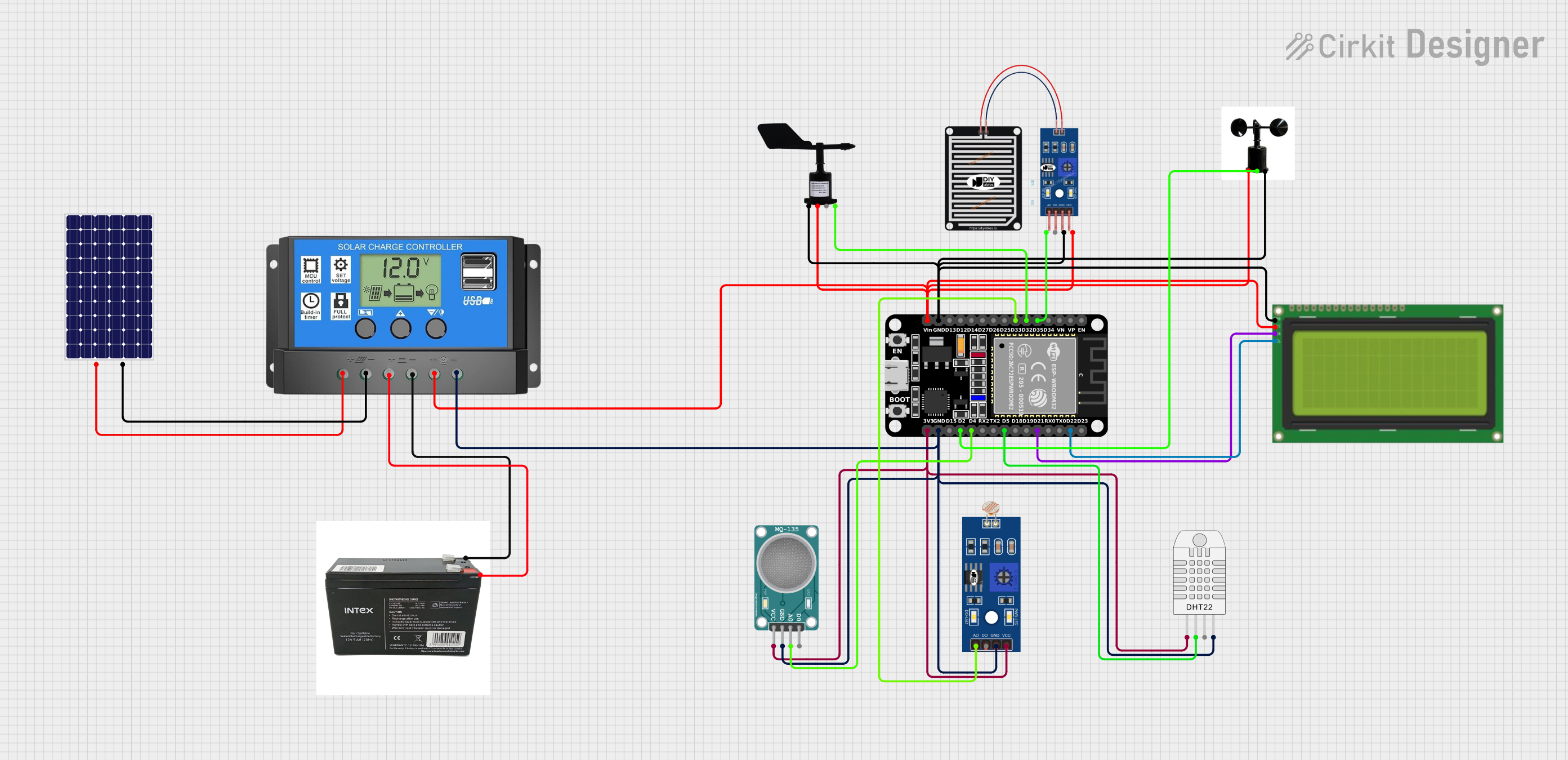
How to Use WIND TURBINE: Examples, Pinouts, and Specs

 Design with WIND TURBINE in Cirkit Designer
Design with WIND TURBINE in Cirkit DesignerIntroduction
A wind turbine is a device that converts kinetic energy from wind into mechanical energy, which can then be transformed into electrical energy. It typically consists of blades, a rotor, a generator, and a tower. Wind turbines are a key component in renewable energy systems and are widely used to generate electricity in both small-scale and large-scale applications.
Explore Projects Built with WIND TURBINE

 Open Project in Cirkit Designer
Open Project in Cirkit Designer
 Open Project in Cirkit Designer
Open Project in Cirkit Designer
 Open Project in Cirkit Designer
Open Project in Cirkit Designer
 Open Project in Cirkit Designer
Open Project in Cirkit DesignerExplore Projects Built with WIND TURBINE

 Open Project in Cirkit Designer
Open Project in Cirkit Designer
 Open Project in Cirkit Designer
Open Project in Cirkit Designer
 Open Project in Cirkit Designer
Open Project in Cirkit Designer
 Open Project in Cirkit Designer
Open Project in Cirkit DesignerCommon Applications and Use Cases
- Renewable Energy Generation: Used in wind farms to produce electricity for residential, commercial, and industrial use.
- Off-Grid Power Systems: Provides power in remote areas where grid electricity is unavailable.
- Hybrid Energy Systems: Often combined with solar panels and batteries for continuous power supply.
- Educational Projects: Used in schools and universities to teach principles of renewable energy and mechanical-to-electrical energy conversion.
Technical Specifications
Key Technical Details
| Parameter | Specification |
|---|---|
| Rated Power Output | 100W to 5MW (varies by model) |
| Operating Wind Speed | 3 m/s to 25 m/s |
| Cut-In Wind Speed | 3 m/s |
| Cut-Out Wind Speed | 25 m/s |
| Rotor Diameter | 1m to 120m (varies by model) |
| Generator Type | Permanent Magnet or Induction |
| Output Voltage | 12V, 24V, or 48V (small turbines) |
| Tower Height | 10m to 100m (varies by application) |
| Efficiency | 30% to 45% (typical for wind turbines) |
Pin Configuration and Descriptions
For small wind turbines with electrical connections, the pin configuration is as follows:
| Pin Number | Label | Description |
|---|---|---|
| 1 | Positive (+) | Positive terminal for DC output voltage |
| 2 | Negative (-) | Negative terminal for DC output voltage |
| 3 | Ground (GND) | Ground connection for safety and stability |
| 4 | Brake Control | Optional pin for connecting a braking system |
Usage Instructions
How to Use the Component in a Circuit
Positioning the Wind Turbine:
- Install the wind turbine in an open area with minimal obstructions to maximize wind exposure.
- Ensure the tower is securely mounted and can withstand high wind speeds.
Electrical Connections:
- Connect the positive (+) and negative (-) terminals of the wind turbine to a charge controller.
- From the charge controller, connect to a battery for energy storage or directly to an inverter for AC power output.
Load Connection:
- If using a battery, connect the load (e.g., appliances) to the battery through an inverter.
- For direct use, ensure the load matches the turbine's output voltage and power rating.
Optional Brake System:
- Connect the brake control pin to a braking circuit to stop the turbine during maintenance or extreme weather conditions.
Important Considerations and Best Practices
- Wind Speed: Ensure the turbine operates within its rated wind speed range to avoid damage.
- Charge Controller: Always use a charge controller to regulate voltage and prevent overcharging of batteries.
- Maintenance: Regularly inspect the blades, rotor, and electrical connections for wear and tear.
- Safety: Install a grounding system to protect against lightning strikes and electrical faults.
Arduino UNO Integration Example
For small wind turbines with a DC output, you can monitor the voltage using an Arduino UNO. Below is an example code to read and display the turbine's output voltage:
// Arduino code to monitor wind turbine voltage
// Connect the turbine's positive output to A0 and negative to GND
const int voltagePin = A0; // Analog pin connected to turbine output
const float voltageDividerRatio = 11.0; // Adjust based on resistor values
const float referenceVoltage = 5.0; // Arduino reference voltage
void setup() {
Serial.begin(9600); // Initialize serial communication
pinMode(voltagePin, INPUT); // Set the voltage pin as input
}
void loop() {
int rawValue = analogRead(voltagePin); // Read the analog value
float voltage = (rawValue * referenceVoltage / 1023.0) * voltageDividerRatio;
// Print the voltage to the Serial Monitor
Serial.print("Wind Turbine Voltage: ");
Serial.print(voltage);
Serial.println(" V");
delay(1000); // Wait for 1 second before the next reading
}
Note: Use a voltage divider circuit to step down the turbine's output voltage to a safe level for the Arduino's analog input (0-5V).
Troubleshooting and FAQs
Common Issues and Solutions
Low Power Output:
- Cause: Insufficient wind speed or obstructions.
- Solution: Relocate the turbine to a higher or more open area.
Overheating of Generator:
- Cause: Prolonged operation at high wind speeds.
- Solution: Install a braking system or shut down the turbine during extreme winds.
No Output Voltage:
- Cause: Loose or damaged electrical connections.
- Solution: Inspect and secure all connections.
Excessive Noise:
- Cause: Worn-out bearings or unbalanced blades.
- Solution: Replace bearings and balance the blades.
FAQs
Q: Can I use a wind turbine without a battery?
- A: Yes, but you will need an inverter to directly power AC loads or connect to the grid.
Q: How do I protect the turbine during storms?
- A: Use a braking system or manually shut down the turbine to prevent damage.
Q: What is the lifespan of a wind turbine?
- A: Most wind turbines have a lifespan of 20-25 years with proper maintenance.
Q: Can I connect multiple turbines to one system?
- A: Yes, but ensure the charge controller and inverter can handle the combined power output.
This documentation provides a comprehensive guide to understanding, using, and maintaining a wind turbine for various applications.